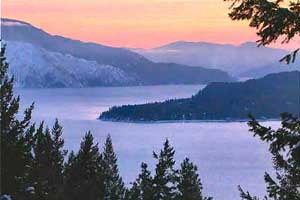Lake Pend Oreille

Lake Pend Oreille (pronounced Pon-duh-ray), is Idaho's biggest lake and is the fifth largest lake in the western United States. The name of the lake originated from French hunters from Canada, the French term meaning "looks like ear" because Pend Oreille is shaped like an ear, not that you can tell that when you are on the water. Lake Pend Oreille is approximately 65 miles long and 15 miles wide at the widest spot at the North end of the lake and it can create its own weather. With 111 miles of of breathtaking shoreline, Lake Pend Oreille boasts world class fishing, boating, and water sports.
In prehistoric times, Lake Pend Oreille was part of a massive inland sea called Lake Missoula, which was formed by an ice dam created by huge glaciers protruding down the Purcell Trench that extends down from Canada through the Kootenai Valley. An ice damm standing about 3,000 feet high formed at the cabinet gorge area holding back the waters of Lake Missoula. When the ice dam collapsed and in less than 48 hours Lake Missoula was drained. The force of the 2,000-foot wall of water shooting out of Clark Fork stripped away soil, moving large boulders, and creating deep canyons, or coulees, in the bedrock. There the rush of water was slowed by a narrow passage called the Wallula Gap. This narrow gap caused the waters to back up and a 1,200-foot lake was formed.
Lake Pend Oreille is presently 1,100 + feet deep and at 2,063 feet above sea level. During the Second World War the largest Navel Base in the World, Farragut was here an Lake Pend Oreille. Presently it is an acting Sonar Testing Navel Base and the 4,000 acres of the base ground is a Idaho State Park with many wonderful camping and recreation spots. For our bird lovers the lake is home to Bald eagles, osprey, herons, hawks, kestrals, and is an anglers paradise. Smallmouth bass, largemouth bass, crappie, sunfish, perch, northern pike, bullhead, Rocky Mountain whitefish, pygmy whitefish, squawfish, tench, longnose sucker, large-scale sucker, redside shiner, longnose dace, sculpin and peamouth. White sturgeon and burbot and Kamloops, also known as a Gerrard rainbow .
The Clark Fork river and Pend Orielle were once well revered for its kokanee -- a land-locked subspecies of sockeye salmon native to the Pacific Northwest but not to Lake Pend Oreille. They arrived in 1933 when a spring flood swept them out of Flathead Lake in Montana. By the '50s a commercial kokanee fishery evolved with 1 million fish harvested annually. In 1995, Jim Eversole caught the largest game fish ever taken from Lake Pend Oreille, a 43 lb. 6 oz. mackinaw also known as the lake trout. The lake also claims the world record for a rainbow trout, a 37-pounder caught in 1947 by Wes Hamlet. No matter where you fish in Lake
Pend Oreille, it's a good bet you'll have a great day on the water.

0 Comments:
Post a Comment
<< Home